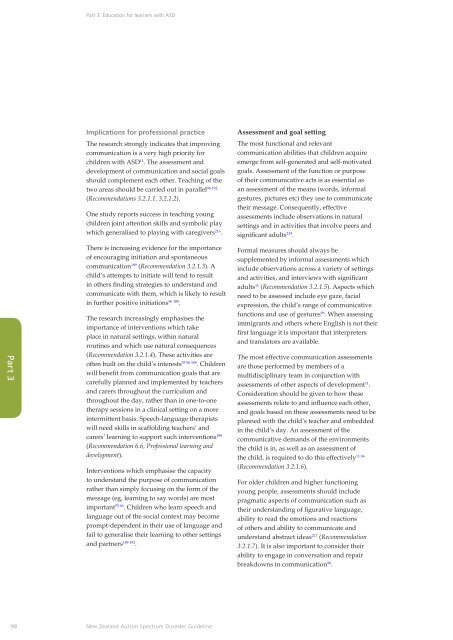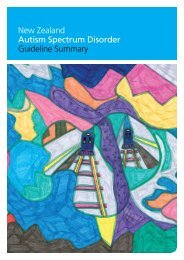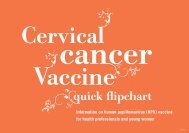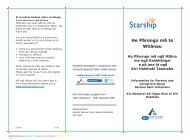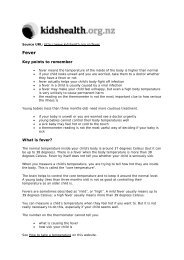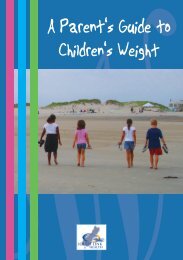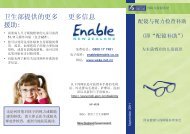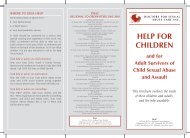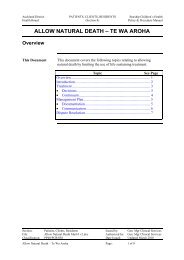New Zealand Autism Spectrum Disorder Guideline - Ministry of Health
New Zealand Autism Spectrum Disorder Guideline - Ministry of Health
New Zealand Autism Spectrum Disorder Guideline - Ministry of Health
You also want an ePaper? Increase the reach of your titles
YUMPU automatically turns print PDFs into web optimized ePapers that Google loves.
Part 3: Education for learners with ASD<br />
Implications for pr<strong>of</strong>essional practice<br />
The research strongly indicates that improving<br />
communication is a very high priority for<br />
children with ASD 11 . The assessment and<br />
development <strong>of</strong> communication and social goals<br />
should complement each other. Teaching <strong>of</strong> the<br />
96 192<br />
two areas should be carried out in parallel<br />
(Recommendations 3.2.1.1, 3.2.1.2).<br />
One study reports success in teaching young<br />
children joint attention skills and symbolic play<br />
which generalised to playing with caregivers 216 .<br />
Assessment and goal setting<br />
The most functional and relevant<br />
communication abilities that children acquire<br />
emerge from self-generated and self-motivated<br />
goals. Assessment <strong>of</strong> the function or purpose<br />
<strong>of</strong> their communicative acts is as essential as<br />
an assessment <strong>of</strong> the means (words, informal<br />
gestures, pictures etc) they use to communicate<br />
their message. Consequently, effective<br />
assessments include observations in natural<br />
settings and in activities that involve peers and<br />
significant adults 215 .<br />
Part 3<br />
There is increasing evidence for the importance<br />
<strong>of</strong> encouraging initiation and spontaneous<br />
communication 189 (Recommendation 3.2.1.3). A<br />
child’s attempts to initiate will tend to result<br />
in others finding strategies to understand and<br />
communicate with them, which is likely to result<br />
in further positive initiations 96 189 .<br />
The research increasingly emphasises the<br />
importance <strong>of</strong> interventions which take<br />
place in natural settings, within natural<br />
routines and which use natural consequences<br />
(Recommendation 3.2.1.4). These activities are<br />
<strong>of</strong>ten built on the child’s interests 55 96 189 . Children<br />
will benefit from communication goals that are<br />
carefully planned and implemented by teachers<br />
and carers throughout the curriculum and<br />
throughout the day, rather than in one-to-one<br />
therapy sessions in a clinical setting on a more<br />
intermittent basis. Speech-language therapists<br />
will need skills in scaffolding teachers’ and<br />
carers’ learning to support such interventions 189<br />
(Recommendation 6.6, Pr<strong>of</strong>essional learning and<br />
development).<br />
Interventions which emphasise the capacity<br />
to understand the purpose <strong>of</strong> communication<br />
rather than simply focusing on the form <strong>of</strong> the<br />
message (eg, learning to say words) are most<br />
important 55 96 . Children who learn speech and<br />
language out <strong>of</strong> the social context may become<br />
prompt-dependent in their use <strong>of</strong> language and<br />
fail to generalise their learning to other settings<br />
and partners 189 192 .<br />
Formal measures should always be<br />
supplemented by informal assessments which<br />
include observations across a variety <strong>of</strong> settings<br />
and activities, and interviews with significant<br />
adults 11 (Recommendation 3.2.1.5). Aspects which<br />
need to be assessed include eye gaze, facial<br />
expression, the child’s range <strong>of</strong> communicative<br />
functions and use <strong>of</strong> gestures 96 . When assessing<br />
immigrants and others where English is not their<br />
first language it is important that interpreters<br />
and translators are available.<br />
The most effective communication assessments<br />
are those performed by members <strong>of</strong> a<br />
multidisciplinary team in conjunction with<br />
assessments <strong>of</strong> other aspects <strong>of</strong> development 11 .<br />
Consideration should be given to how these<br />
assessments relate to and influence each other,<br />
and goals based on these assessments need to be<br />
planned with the child’s teacher and embedded<br />
in the child’s day. An assessment <strong>of</strong> the<br />
communicative demands <strong>of</strong> the environments<br />
the child is in, as well as an assessment <strong>of</strong><br />
11 96<br />
the child, is required to do this effectively<br />
(Recommendation 3.2.1.6).<br />
For older children and higher functioning<br />
young people, assessments should include<br />
pragmatic aspects <strong>of</strong> communication such as<br />
their understanding <strong>of</strong> figurative language,<br />
ability to read the emotions and reactions<br />
<strong>of</strong> others and ability to communicate and<br />
understand abstract ideas 217 (Recommendation<br />
3.2.1.7). It is also important to consider their<br />
ability to engage in conversation and repair<br />
breakdowns in communication 96 .<br />
98<br />
<strong>New</strong> <strong>Zealand</strong> <strong>Autism</strong> <strong>Spectrum</strong> <strong>Disorder</strong> <strong>Guideline</strong>


